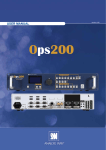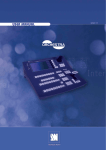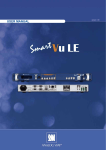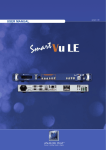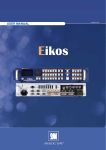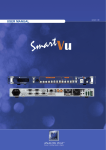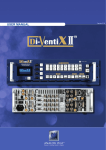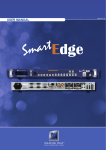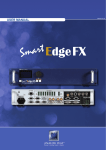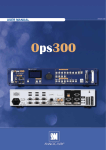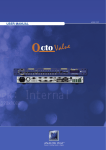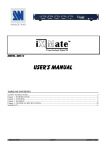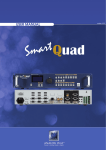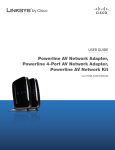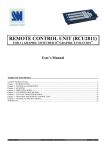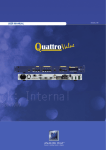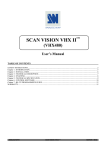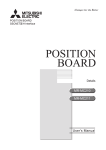Download User Manual - QED Productions
Transcript
version 1.0 THANK YOU Thank you for choosing Analog Way. By following these simple steps, you should be able to unleash the powerfull Pulse Multi Layer Hi-resolution Mixer and Seamless Switcher capabilities straight out of the box. TABLE OF CONTENTS 1 INTRODUCTION 6 WHAT IS PULSE 6 USEFUL TERMS AND DEFINITIONS 6 Background Layer PIP (Picture In Picture) Frames Logos Keying HARDWARE INSTALLATION 8 SAFETY PRECAUTIONS 8 UNPACKING AND INSPECTION 13 RACKMOUNT INFORMATION 13 CABLE AND ADAPTOR INFORMATION 14 HARDWARE SPECIFICATIONS 14 Input specifications Output specifications Communication specifications Environmental specifications Pin outs HDCP compliance 1 CONNECTING THE PULSE 21 CONNECTING THE PULSE 21 PULSE REAR PANEL 22 Overview Inputs #1 - #4 DVI Inputs #1 - #2 SD/HD-SDI Inputs #1 - #2 Preview outputs Main outputs OPERATING THE PULSE PULSE FRONT PANEL 26 26 Overview Standby button Menu section Input Selection section Preset Selection button PIP button LOGO button Freeze button Background Frame button Background Live button Effect Selection button Take button PULSE MENU 29 Home menu Menu screen and knobs Menu tree WORKING WITH THE PULSE Resetting default values Pulse color codes Source input selection Input selection settings Source output selection Output selection settings 2 36 Working with PIPs PIP configuration PIPs as layers Memorizing frames in the Pulse Working with frames Memorizing logos in the Pulse Working with logos Mixer functions Layer transitions and effects Working with presets Preset configuration Using presets Working with audio Audio configuration REMOTE CONTROL SOFTWARE THE PULSE RCS 44 44 RCS presentation Software installation Software overview Serial connection Ethernet connection WORKING WITH THE RCS 45 Source input configuration Source output configuration Working with PIPs PIP configuration Working with frames Memorizing frames in the Pulse Working with logos Memorizing logos in the Pulse Layer transitions and effects Working with presets Preset configuration Using presets 3 Working with audio Audio configuration OPTIONAL REMOTE CONTROL SYSTEM 52 ORCHESTRA 52 APPLICATION NOTES AND TIPS 52 ABOUT APPLICATION NOTES 52 APPLICATION NOTES 53 Application Note #1 Application Note #2 EXTERNAL PROGRAMMING 56 WARRANTY AND SERVICES INFORMATION 57 ANALOG WAY LIMITED WARRANTY 57 SERVICES AND RMA 57 CONTACT INFORMATION HOW TO CONTACT US 58 58 After sales services Analog Way offices worldwide Regional contact information The Analog Way website INFORMATION ON DISPOSAL 4 59 INTRODUCTION MIXER MODE This mode allows for a single Pulse to seamlessly switch and blend any of its 10 analog/digital inputs with any other of the inputs, add PIP, titling or logo insertion on the live frame, while previewing your every move before going live. The Mixer mode is the Pulse native mode, and will display up to 4 layers (of which 2 live layers). USEFUL TERMS AND DEFINITIONS BACKGROUND : a “Background” is a source, typically originating from a computer. Pulse enables you to work with live or still (frame) background sources - visually in back of all other sources. LAYER : a “Layer” is an image display element (such as a PIP, Key, Logos or Background) that has an associated visual priority — either in front (or in back) of another layer. The Pulse can simultaneously view no less than 4 layers (2 video, or live layers, 1 frame layer, or background, and 2 logo layers). Pulse can insert up to 1 PIP on a live background, plus 2 logos. PIP : a “PIP” (Picture In Picture), is a picture, typically of reduced size, which is positioned over another background image or PIP. PIPs can be reduced, enlarged, bordered and shadowed. PIPs can overlap, depending on their visual priority. Pulse allows for Dynamic PIP on the opening and closing of the sequence, vertically or horizontally. A “flying” PIP is also possible over the screen with vertical, horizontal or diagonal animation. A PIP is considered as a live layer. FRAME : a “Frame” is a full screen image which is selected from one of the eight still frames which you can capture with the Pulse. A Frame can be flash captured and imported from any video or computer source plugged into the machine. LOGO : a “Logo” is a part of screen image that can be flash captured and imported from any Video or Computer source, by keying or image cut-out. Pulse can record up to 8 still logos. They can be positioned anywhere on the screen. KEYING : a “Key” is an electronic process whereby an image is electronically superimposed over another source or background, by cutting out either a color (chroma key), or its brightness or luminance levels (luma key) . Keys are typically used for titles, logos and special effects. Pulse allows to use a live source with green or blue background and to key it over any other live input. Pulse allows to use a live source with green or blue background and to key it over any other live input. 5 HARDWARE INSTALLATION SAFETY PRECAUTIONS All of the safety and operating instructions should be read before the product is operated and should be maintained for further reference. Please follow all of the warnings on this product and its operating instructions. WARNING : To prevent the risk of electric shock and fire, do not expose this device to rain, humidity, intense heat sources (such as heaters and direct sunlight). Slots and openings in the device are provided for ventilation and to avoid overheating. Make sure the device is never placed near a textile surface that could block the openings. Also keep away from excessive dust, vibrations and shocks. POWER : Only use the power supply indicated on the device of the power source. Devices equipped with a grounding plug should only be used with a grounding type outlet. In no way should this grounding be modified, avoided or suppressed. POWER CORD : The device is equipped with a main switch (On (I) /Off (O)). The Switch ON and OFF is initiated by the main switch. Caution: The power cord constitute the only mean to totaly disconnect the equipment from the main power. Apply the following guidelines: - The equipment connected to the network must have a release system easily accessible and located outside the unit. - Unplug the power cord, do not pull on the power cord but always on the plug itself. - The outlet should always be near the device and easily accessible. - Power supply cords should be routed so that they are not likely to be walked on or pinched by items placed upon or against them. If the power supply cord is damaged, unplug the device. Using the device with a damaged power supply cord may expose your device to electric shocks or other hazards. Verify the condition of the power supply cords once in a while. Contact your dealer or service center for replacement if damaged. CONNECTIONS : All inputs and outputs (except for the power input) are TBTS defined under EN60950. SERVICING : Do not attempt to service this product yourself by opening or removing covers and screws since it may expose your device to electric shocks or other hazards. Refer all problems to qualified service personnel. OPENINGS : Never push objects of any kind into this product through the openings. If liquids have been spilled or objects have fallen into the device, unplug it immediately and have it checked by a qualified technician. 6 INSTRUCTIONS DE SÉCURITÉ Afin de mieux comprendre le fonctionnement de cet appareil nous vous conseillons de bien lire toutes les consignes de sécurité et de fonctionnement de l’appareil avant utilisation. Conserver les instructions de sécurité et de fonctionnement afin de pouvoir les consulter ultérieurement. Respecter toutes les consignes marquées dans la documentation, sur le produit et sur ce document. ATTENTION : Afin de prévenir tout risque de choc électrique et d’incendie, ne pas exposer cet appareil à la pluie, à l’humidité et aux sources de chaleur intense. INSTALLATION : Veillez à assurer une circulation d’air suffisante pour éviter toute surchauffe à l’intérieur de l’appareil. Ne placez pas l’appareil sur ou à proximité d’une surface textile susceptible d’obstruer les orifices de ventilation. N’installez pas l’appareil à proximité de sources de chaleur comme un radiateur ou une poche d’air chaud, ni dans un endroit exposé au rayonnement solaire direct, à des poussières excessives, à des vibrations ou à des chocs mécaniques. Ceci pourrait provoquer un mauvais fonctionnement et un accident. ALIMENTATION : Ne faire fonctionner l’appareil qu’avec la source d’alimentation indiquée sur l’appareil. Les appareils doivent être obligatoirement connectés sur une source équipée d’une mise à la terre efficace. En aucun cas cette liaison de terre ne devra être modifiée, contournée ou supprimée. CORDON D’ALIMENTATION : Les appareils sont équipés d’un interrupteur général (Marche I / Arrêt O), la mise en tension et la mise hors tension se fait en actionnant cet interrupteur général. Attention : Le cordon d’alimentation constitue le seul moyen de débrancher l’appareil totalement de l’alimentation secteur. Pour être certain que l’appareil n’est plus alimenté, ce cordon doit être débranché de la prise murale. Appliquer les consignes suivantes : - Le matériel relié a demeure au réseau, doit avoir un dispositif de sectionnement facilement accessible qui doit être incoporé à l’extérieur de l’appareil. - Débrancher le cordon d’alimentation de la prise murale si vous prévoyez de ne pas utiliser l’appareil pendant quelques jours ou plus. - Pour débrancher le cordon, tirez le par la fiche. Ne tirez jamais sur le cordon proprement dit. - La prise d’alimentation doit se trouver à proximité de l’appareil et être aisément accessible. - Ne laissez pas tomber le cordon d’alimentation et ne posez pas d’objets lourds dessus. Si le cordon d’alimentation est endommagé, débranchez le immédiatement de la prise murale. Il est dangereux de faire fonctionner un appareil avec un cordon endommagé, un câble abîmé peut provoquer un risque d’incendie ou un choc électrique. Vérifier le câble d’alimentation de temps en temps. Contacter votre revendeur ou le service après vente pour un remplacement. CONNEXIONS : Toutes les entrées et sorties (exceptée l’entrée secteur) sont de type TBTS (Très Basse Tension de Sécurité) définies selon EN 60950. RÉPARATION ET MAINTENANCE : L’utilisateur ne doit en aucun cas essayer de procéder aux opérations de dépannage, car l’ouverture des appareils par retrait des capots ou de toutes autres pièces constituant les boîtiers ainsi que le dévissage des vis apparentes à l’extérieur, risque d’exposer l’utilisateur à des chocs électriques ou autres dangers. Contacter le service après vente ou votre revendeur ou s’adresser à un personnel qualifié uniquement. OUVERTURES ET ORIFICES : Les appareils peuvent comporter des ouvertures (aération, fentes, etc...), veuillez ne jamais y introduire d’objets et ne jamais obstruer ses ouvertures. Si un liquide ou un objet pénètre à l’intérieur de l’appareil, débranchez immédiatement l’appareil et faites le contrôler par un personnel qualifié avant de le remettre en service. 18 7 INSTRUZIONI DI SECUREZZA Allo scopo di capire meglio il funzionamento di questa apparecchiatura vi consigliamo di leggere bene tutti i consigli di sicurezza e di funzionamento prima dell’utilizzo. Conservare le istruzioni di sicurezza e di funzionamento al fine di poterle consultare ulteriormente. Seguire tutti i consigli indicati su questo manuale e sull’apparecchiatura. ATTENZIONE : Al fine di prevenire qualsiasi rischio di shock elettrico e d’incendio, non esporre l’apparecchiatura a pioggia, umidità e a sorgenti di eccessivo calore. INSTALLAZIONE : Assicuratevi che vi sia una sufficiente circolazione d’aria per evitare qualsiasi surriscaldamento all’interno dell’apparecchiatura. Non collocare l’apparecchiatura in prossimità o su superfici tessili suscettibili di ostruire il funzionamento della ventilazione. Non installate l’apparecchiatura in prossimità di sorgenti di calore come un radiatore o una fuoruscita d’aria calda, né in un posto esposto direttamente ai raggi del sole, a polvere eccessiva, a vibrazioni o a shock meccanici. Ció potrebbe provocare un erroneo funzionamento e un incidente. ALIMENTAZIONE : Far funzionare l’apparecchiatura solo con la sorgente d’alimentazione indicata sull’apparecchiatura. Le apparecchiature queste devono essere obbligatoriamente collegate su una sorgente fornita di una efficiente messa a terra. In nessun caso questo collegamento potrà essere modificato, sostituito o eliminato. CAVO DI ALIMENTAZIONE : Gli apparecchi con un interrutore (commutatore) generale (Accesso I: Speuto 0), accendere ou spagnere l’apparecchio si fa usando l’interrutore. Attenzione : il cavo di alimentazione è il solo modo di disconnettere l’apparecchio dell’alimentazione. Per assicurarsi che totalemente l’apparecchio non è più collegato, il cavo deve essere disconesso della presa murale. Seguire le instruzioni seguenti : - Il materiale collegato a residenza alla rete, deve avere un dispositivo di sezionamento facile da raggiongere eche deve essere inserito all’esterno del apparecchio. - Disconnettere l’apparecchiatura dalla presa murale se si prevede di non utilizzarla per qualche giorno. - Per disconnettere il cavo tirare facendo forza sul connettore. - La presa d’alimentazione deve trovarsi in prossimità dell’apparecchiatura ed essere facilmente accessibile. - Non far cadere il cavo di alimentazione né appoggiarci sopra degli oggetti pesanti. Se il cavo di alimentazione é danneggiato, spegnere immediatamente l’apparecchiatura. E’ pericoloso far funzionare questa apparecchiatura con un cavo di alimentazione danneggiato, un cavo graffiato puó provocare un rischio di incendio o uno shock elettrico. Verificare il cavo di alimentazione spesso. Contattare il vostro rivenditore o il servizio assistenza per una sostituzione. CONNESSIONE : Tutti gli ingressi e le uscite (eccetto l’alimentazione) sono di tipo TBTS definite secondo EN 60950. RIPARAZIONI E ASSISTENZA : L’utilizzatore non deve in nessun caso cercare di riparare l’apparecchiatura, poiché con l’apertura del coperchio metallico o di qualsiasi altro pezzo costituente la scatola metallica, nonché svitare le viti che appaiono esteriormente, poiché ció puó provocare all’utilizzatore un rischio di shock elettrico o altri rischi. APERTURE DI VENTILAZIONE : Le apparecchiature possono comportare delle aperture di ventilazione, si prega di non introdurre mai oggetti o ostruire le sue fessure. Se un liquido o un oggetto penetra all’interno dell’apparecchiatura, disconnetterla e farla controllare da personale qualificato prima di rimetterla in servizio. 8 SICHERHEITSHINWEISE Um den Betrieb dieses Geräts zu verstehen, raten wir Ihnen vor der Inbetriebnahme alle Sicherheits und Betriebsanweisungen genau zu lesen. Diese Sicherheits- und Betriebsanweisungen für einen späteren Gebrauch sicher aufbewahren. Alle in den Unterlagen, an dem Gerät und hier angegebenen Sicherheitsanweisungen einhalten. ACHTUNG : um jegliches Risiko eines Stromschlags oder Feuers zu vermeiden, das Gerät nicht Regen, Feuchtigkeit oder intensiven Wärmequellen aussetzen. EINBAU : Eine ausreichende Luftzufuhr sicherstellen, um jegliche Überhitzung im Gerät zu vermeiden. Das Gerät nicht auf und in Nähe von Textiloberflächen, die Belüftungsöffnungen verschließen können, aufstellen. Das Gerät nicht in Nähe von Wärmequellen, wie z.B. Heizkörper oder Warmluftkappe, aufstellen und es nicht dem direkten Sonnenlicht, übermäßigem Staub, Vibrationen oder mechanischen Stößen aussetzen. Dies kann zu Betriebsstörungen und Unfällen führen. STROMVERSORGUNG : Das Gerät nur mit der auf dem Gerät bezeichnete Stromquelle betreiben. Gerät mit geerdeter Hauptstromversorgung muss an eine Stromquelle mit effizienter Erdung angeschlossen werden. Diese Erdung darf auf keinen Fall geändert, umgangen oder entfernt werden. NETZKABEL: Da die Geräte über einen Hauptschalter (An I/ Aus 0) verfügen, erfolgt die Stromversorgung und -unterbrechung über diesen Hauptschalter. Achtung : Das Netzkabel stellt die einzige Möglichkeit dar, das Gerät vollständig vom Netzanschluss zu trennen. Um sicherzustellen, dass das Gerät nicht mehr versorgt wird, muss dieses Kabel aus der Netzsteckdose ausgesteckt werden. Bitte beachten Sie die folgenden Hinweise : - Wenn Geräte dauerhaft am Netz bleiben, müssen sie über eine leicht zugängliche Trennvorrichtung verfügen, die außen am Gerät angebracht sein muss. - Das Kabel mittels dem Stecker herausziehen. Niemals am Stromkabel selbst ziehen. - Die Steckdose muß sich in der Nähe des Geräts befinden und leicht zugänglich sein. - Das Stromkabel nicht fallen lassen und keine schweren Gegenstände auf es stellen. Wenn das Stromkabel beschädigt ist, das Gerät sofort abschalten. Es ist gefährlich das Gerät mit einem beschädigten Stromkabel zu betreiben; ein abgenutztes Kabel kann zu einem Feuer oder Stromschlag führen. Das Stromkabel regelmäßig untersuchen. Für den Ersatz, wenden Sie sich an Ihren Verkäufer oder Kundendienststelle. ANSCHLÜSSE : Bei allen Ein- und Ausgängen (außer der Stromversorgung) handelt es sich, gemäß EN 60950, um Sicherheits Kleinspannunganschlüsse. REPARATUR UND WARTUNG : Der Benutzer darf keinesfalls versuchen das Gerät selbst zu reparieren, die Öffnung des Geräts durch Abnahme der Abdeckhaube oder jeglichen anderen Teils des Gehäuses sowie die Entfernung von außen sichtbaren Schrauben zu Stromschlägen oder anderen Gefahren für den Benutzer führen kann. Wenden Sie sich an Ihren Verkäufer, Ihre Kundendienststelle oder an qualifizierte Fachkräfte. ÖFFNUNGEN UND MUNDUNGEN : Die Geräte können über Öffnungen verfügen (Belüftung, Schlitze, usw.). Niemals Gegenstände in die Öffnungen einführen oder die Öffnungen verschließen. Wenn eine Flüssigkeit oder ein Gegenstand in das Gerät gelangt, den Stecker herausziehen und es vor einer neuen Inbetriebnahme von qualifiziertem Fachpersonal überprüfen lassen. 18 9 INSTRUCCIONES DE SEGURIDAD Para comprender mejor el funcionamiento de este aparato, le recomendamos que le acuidadosamente todas las consignas de seguridad y de funcionamiento del aparato antes de usarlo. Conserve las instrucciones de seguridad y de funcionamiento para que pueda consultarlas posteriormente. Respete todas las consignas indicadas en la documentación, relacionadas con el producto y este documento. CUIDADO : Para prevenir cualquier riesgo de choque eléctrico y de incendio, no exponga este aparato a la lluvia, a la humedad ni a fuentes de calorintensas. INSTALACIÓN : Cerciórese de que haya una circulación de aire suficiente para evitar cualquier sobrecalentamiento al interior del aparato. No coloque el aparato cerca ni sobre una superficie textil que pudiera obstruir los orificios de ventilación. No instale el aparato cerca de fuentes de calor como radiador o boca de aire caliente, ni en un lugar expuesto a los rayos solares directos o al polvo excesivo, a las vibraciones o a los choques mecánicos. Esto podría provocar su mal funcionamiento o un accidente. ALIMENTACIÓN : Ponga a funcionar el aparato únicamente con la fuente de alimentación que se indica en el aparato. Los aparatos deben estar conectados obligatoriamente a una fuente equipada con una puesta a tierra eficaz. Por ningún motivo este enlace de tierra deberá ser modificado, cambiado o suprimido. CABLE DE ALIMENTACIÓN : Los equipos incluyan interruptor general de alimentación (Encender I / Apagar 0), la puesta en marcha o desconexión se realiza por medio de este interruptor. El cable de alimentación constituye el único medio de desconectar el aparato totalmente de la red eléctrica. Para estar seguro de que el aparato no está más alimentado, este cable debe de ser desconectado de la toma de corriente. Aplicar las siguientes consignas: - El material conectado a residencia a la red informática, debe de tener un dispositivo de seccionamiento fácilmente accesible que debe de ser incorporado al exterior del aparato. - Desconectar el aparato del enchufe mural si no piensa utilizarlo durante varios días. - Para desconectar el cable, tire de la clavija. No tire nunca del cable propiamente dicho. - El enchufe de alimentación debe estar cerca del aparato y ser de fácil acceso. - No deje caer el cable de alimentación ni coloque objetos pesados encima de él. Si el cable de alimentación sufriera algún daño, ponga el aparato inmediatamente fuera de tensión. Es peligroso hacer funcionar este aparato con un cable averiado, ya que un cable dañado puede provocar un incendio o un choque eléctrico. Verifique el estado del cable de alimentación de vez en cuando. Póngase en contacto con su distribuidor o con el servicio de posventa si necesita cambiarlo. CONEXIONES : Todas las entradas y salidas (excepto la entrada del sector) son de tipo TBTS (Muy Baja Tensión de Seguridad) definidas según EN 60950 REPARACIÓN Y MANTENIMIENTO : Por ningún motivo, el usuario deberá tratar de efectuar operaciones de reparación, ya que si abre los aparatos retirando el capó o cualquier otra pieza que forma parte de las cajas o si destornilla los tornillos aparentes exteriores, existe el riesgo de producirse una explosión, choques eléctricos o cualquier otro incidente. Contacte el servicio de posventa, a su distribuidor o dirigirse con personal cualificado únicamente. ABERTURAS Y ORIFICIOS : Los aparatos pueden contener aberturas (aireación, ranuras, etc.). No introduzca allí ningún objeto ni obstruya nunca estas aberturas. Si un líquido o un objeto penetra al interior del aparato, desconéctelo y hágalo revisar por personal cualificado antes de ponerlo nuevamente en servicio. 10 UNPACKING AND INSPECTION 1 x Pulse seamless scaler/switcher 1 x Power supply cord 2 x DVI male to HD15 female and DVI female cable 1 x HD15 to 5 BNC cable 1 x Ethernet cross cable (for device update) 1 x Set of 3 audio 5 pin screw terminals 1 x RCS (Remote Control Software) CD-ROM (PC only) 1 x User manual on CD-ROM 1 x Quick Start guide RACKMOUNT INFORMATION Tabletop mounting : The Pulse can be used directly on a table, the unit is equipped with 4 handy anti-slip rubber feet. Rack mounting : The Pulse is compatible with a 19” enclosure. Please follow the instructions below to install the device in a 19” rack. Place the device in your rack. Attach the device to the rack by using 4 screws through the front panel holes (screws not included). Rear fixing is also recommended, in particular for permanent installations. The Pulse is equipped with drill holes designed for compatibility with most rackmount braces. Connect all of the cables of the device and attach them to the rack with the help of tie wraps. IMPORTANT : - The openings in the side and rear panels of the device are for cooling. Do not cover these openings to avoid cutting air circulation. - Be sure that no weight in excess of 2 kg (4.4 Lbs.) is added onto the Pulse. - The maximum ambient operating temperature should not exceed 40 °C (104°F) - The rack and all mounted equipement in it must be reliably grounded according to national and/or local electrical standards. * NOTE * Dismantling front handles of the device will invalidate warranty on after sales services of your Pulse. It is strongly advised to avoid using front handles as rests for your Pulse, they are designed for manipulation purposes only. 11 18 CABLE AND ADAPTOR INFORMATION A large choice of cables and adaptors are compatible with the Pulse. To find which are to be used in your setup, please refer to the Hardware Specifications chapter. Please contact your distributor for a list of available cables and connectors for your Pulse. HARDWARE SPECIFICATIONS Input specifications • ANALOG COMPUTER : Connectors : Inputs 1-4 : female HD15. DVI Inputs 1-2 : female DVI-I (analog pins). Line frequency : Up to 130 kHz (165 MHz Max pixel rate). Resolution : Up to 1600x1200 @ 165Mhz, 1920x1200px (RB, Max V size : 1200px, Max H size 2048px). Sync. types : RGBHV, RGB/S, RGsB (Sync On Green). Levels : R, G, B = 0.7 Vp/p. H & V Sync = TTL Composite Sync = TTL and 0.3 V (negative). SOG (Sync On Green) = 0.3 V. Impedance : R, G, B = 75 ohms. H = 75 ohms or Hi-Z. V = Hi-Z. • RGB/S - RGsB VIDEO : Connectors : Inputs 1-4 : female HD15. DVI Inputs 1-2 : female DVI-I (analog pins). Frequency : 15.625 kHz - 50 Hz (625 lines). 15.734 kHz - 60 Hz (525 lines). Levels : R, G, B = 0.7 Vp/p. SYNC. = 0.3 Vp/p or TTL (negative). Impedance : RGB = 75 ohms. SYNC. = 75 ohms or Hi-Z. • COMPONENT : Connectors : Inputs 1-4 : female HD15. DVI Inputs 1-2 : female DVI-I (analog pins). Frequency : 15.625 kHz - 50 Hz (625 lines). 15.734 kHz - 60 Hz (525 lines). Levels : Y = 1 Vp/p (0.7 V Luma + 0.3 V Sync.). Cr / Pr & Cb / Pb = 0.7 Vp/p. Impedance : 75 ohms. 12 or or or • HDTV - HD-YUV : Connectors : Inputs 1-4 : female HD15. DVI Inputs 1-2 : female DVI-I (analog pins). Formats : 720p/576p (60Hz), 1080i (50/60Hz), EDTV. Levels : Y = 1 Vp/p (0.7 V + sync.). Cr / Pr & Cb / Pb = 1 Vp/p (0.7 V + sync.). Sync. : Tri-level: ±0.3V (positive/negative). Bi-level: 0.3V (negative). Impedance: 75 ohms. • S.VIDEO : Connectors : Standard : Levels : Impedance : Inputs 1-4 : female HD15. DVI Inputs 1-2 : female DVI-I (analog pins). PAL/SECAM : 15.625 kHz - 50Hz - 625 lines. NTSC (3.58 - 4.43 MHz) : 15.734 kHz/60Hz/525 lines. Y = 1 Vp/p (0.7 V Luma + 0.3 V Sync.). C = 0.3 Vp/p (Chroma Burst). 75 ohms. • COMPOSITE VIDEO : Connectors : Inputs 1-4 : female HD15. DVI Inputs 1-2 : female DVI-I (analog pins). Standard : PAL / SECAM: 15.625 kHz - 50 Hz - 625 lines. NTSC (3.58 - 4.43 MHz) : 15.734 kHz/ 60Hz/525 lines. Level : 1 Vp/p (0.7 V Luma + 0.3 V Sync.). Impedance : 75 ohms. or or or • DVI (Digital Video Interface) : Connector : DVI Inputs 1-2 : female DVI-I (digital pins). Line frequency : Up to 130 kHz (165 MHz Max pixel rate). Format : Digital Visual Interface (DVI)-TMDS single link. Resolution : Up to 1600x1200 @ 165Mhz, 1920x1200px (RB, Max V size : 1200px, Max H size 2048px). • SD-SDI : Connector : Formats : Data rate : Impedance : SDI Inputs 1-2 : female BNC. SMPE 259M 270 Mbps serial digital. 75 ohms. 13 • HD-SDI : Connector : Formats : Data rate : Impedance : SDI Inputs 1-2 : female BNC. 720p @ 50, 59.94 & 60 Hz 1035i @ 50, 59.94 & 60 Hz 1080i @ 50, 59.94 & 60 Hz 1080p @ 23.97, 24, 25, 29.97 & 30 Hz. 1080sF @ 50, 59.94 & 60 Hz. 1.5 Gbps serial digital. 75 ohms. Output specifications • ANALOG OUTPUTS Connector : Outputs 1 (Main) & 2 (Preview) : female HD15, DVI-I (analog pins). Resolutions : Signals : Levels : Impedance : RGBHV, RGBS and RGsB. R, G, B = 0.7 Vp/p. Sync. : Separate H & V = TTL (negative). Composite = TTL (negative). SOG = 0.3 Vp/p (negative). R, G, B = 75 ohms. • DVI (Digital Video Interface) OUTPUTS Connector : Outputs 1 (Main) & 2 (Preview) : female DVI-I (digital pins). Signal : Digital Visual Interface (DVI)-TMDS single link. 14 or Resolutions : • AUDIO OUTPUT : Connector : Outputs 1 (Main) and 2 (Prelist) : 2 Balanced or unbalanced mono/stereo outputs (on 5 pin MCO male connector). Vo max : Unbalanced = + 15dBu (at 300Ω load). Balanced = + 21 dBu (at 600Ω load). Zo = 600 Ω balanced. Zo = 300 Ω unbalanced. G = 0 dB nominal. 15 Communication specifications • COMMUNICATION PORTS : REMOTE RS232 Connector : DB 9 female Protocol : RS232. Data Rate : 9600 Bauds, 8 data bits, 1 stop bit, no parity bit, no flow control for normal. DTR & RTS needed for upgrade. • LAN : Connector : Protocol : Ethernet : RJ45 TCP (Transmission Control Protocol) or UDP (User Datagram Protocol). Base 10/100 Environmental specifications Dimensions : W 482 x D 330 x H 45 mm 19”W x 13,8”D x 1,8”H Weight : 4,3 kg / 9,5 lbs. (Compatible with a Standard 19” rack, Height = 1 U). Cooling air flow from right side to left side. Max ambient operating temperature : < 40 °C ( < 104°F). Operating temperature : 0 to 40 °C / +32 ° to +104 °F Storage temperature : -25 to 85 °C / -13° to +185 °F Operating humidity : 10 to 80% (non condensing) Input voltage range : 100-240 VAC, 50/60 Hz Typical consumption : 90 W CE Compliancy, test following : - EN 55022: 2006 / A1 : 2007, - EN 55024: 1998 / A1 : 2001 / A2 : 2003, - EN 61000-3-2: 2006 - EN 61000-3-3: 1995 / A1 : 2001 / A2 : 2005, Safety, test following : - IEC 60950-1:2005 - UL 60950-1: 2007 - CAN/CSA-C22.2 NO. 60950-1 Power supply : IEC/EN/UL/CSA 60950-1, internal, autoswitchable Mecanical (in carton) : Vibration : IEC60068-2-64 Free fall : IEC60068-2-32 RoHS, WEEE 16 Pin outs 16 14 17 HDCP compliance For HDCP (High Definition Copy Protection) sources, HDTV fences will limit component and RGB analog output resolutions to 720p or 1080i. 1080p is available only on HDTV device HDMI or DVI interfaces which employ HDCP encryption. An HDCP session results in the exchange of keys between the source and display devices. The source device will send a query to the display to make sure the equipment is HDCP compliant before video content is shown. Non-HDCP devices, such as PC’s and older model DVI products, will work with any DVI compliant display, but the HDCP compliant boxes will show an image only on HDCP compliant displays. * NOTE * when displaying HDCP protected sources on non HDCP compliant equipment, the following message will be displayed on the device VFD screen : “Due to HDCP content, non HDCP screens cannot display protected sources” Screen will go to black without displaying the HDCP input image, or partially mask out non HDCP content. * TIP * In order to solve HDCP protection problems, try to use the component output of your HDTV device or Blu-Ray player. NOTE : as a part of policy of continuous improvement, Analog Way reserves the right to make design and specification changes for product improvements without prior notice. The performance specification figures indicated are nominal values of production units. There may be some deviations from these values in individual units. 18 14 CONNECTING THE PULSE CONNECTING THE PULSE The Pulse can be set up with up to 10 different sources, and will drive up to 2 digital DVI-D sources, 2 SD-SDI sources and 6 analog computer/video sources simultaneously. The versatility of the Pulse will allow for almost any event configuration and cater for all your projection needs. The intuitive rear panel of the Pulse will let you set up for the first time quickly and easily. Here is an example of a typical Pulse setup. 19 THE PULSE REAR PANEL Overview The Pulse rear panel is equipped with 6 universal digital and analog inputs. Inputs #1 through #4 (4) are universal analog inputs. Inputs #5 & #6 share a DVI-D signal and a universal analog signal (plug the shipped Analog Way DVI/DB15 adaptor cable to use DVI-D and analog signals simultaneously). The Main and Preview (7) outputs will allow for the Pulse high resolution digital and analog signals to be viewed on screen and/or on a preview monitor (see also Output Specifications in this chapter). Finally, the audio in and output card will let users trigger audio with any source, accurately balance or tweak sound sources and outputs. 1 : AC outlet and On/off switch 2 : RS232 connector 3 : IP-LAN connector 4 : Universal Analog inputs 5 : DVI-D inputs 6 : HD-SDI inputs 7 : Main and Preview outputs 8 : Audio inputs 9 : Audio outputs 20 Inputs #1 - #6 UNIVERSAL COMPUTER & VIDEO INPUTS Universal Inputs accept computer sources (RGBHV, RGBS, and RGsB (SOG) signals), standard TV/VIDEO sources (Composite video, S.VIDEO), Component video (YUV, RGBS & RGsB (SOG)), and HDTV sources (480p, 720p & 1080i). HD15 : 1 x Universal Analog input on female HD15 connector. COMPUTER SOURCES: The device accepts the following computer signals : RGBHV, RGB/S, and RGsB on inputs 1-4 and DVI inputs 1-2. COMPOSITE VIDEO SOURCES: The Composite Video signal, usually called COMPOSITE or VIDEO, is available on most video equipment (VCR, DVD, CAMCORDER…), but is also the lowest in picture quality. The video standard of this signal can be NTSC, PAL or SECAM. The signal is transmitted on a single coaxial cable, and is connected to the video equipment with an HD15 connector. For inputs 1-4 : connect a 1 x BNC from your composite source, to the HD15 input of the device. S.VIDEO SOURCES: The S.VIDEO signal, also called Y/C, HI-8™, or S.VHS™, is available on DVD players and high quality VCRs (S.VHS). The S.VIDEO signal in which the Luminance (Y) and Chrominance (C) information are separately transmitted, gives a higher quality picture than the Composite video signal. The S.VIDEO connector is usually a 4 pin Mini-DIN connector also called Oshiden™ connector. For inputs 1-4 : connect a 2 x BNC from your S.VIDEO, Y (G/Y) & C (R/R-Y), to the HD15 input of the device. COMPONENT VIDEO SOURCES: The Component Video signal, also called YUV (Y, Pr, Pb) or BETACAM™ is widely used in broadcasting and is available on high-quality DVD players. The COMPONENT signal is transmitted with 3 coaxial cables, and also has a better quality picture than COMPOSITE and S.VIDEO signals. The COMPONENT connectors are usually RCA (x3), or BNC (x3). For inputs #1 to #4: connect a HD15 to 3 x BNC cable between the HD15 connector of the device and your Component source. 21 RGBS VIDEO SOURCES: This signal is widely used in broadcasting and is available on European DVD player. The RGB/S signal is transmitted with 4 coaxial cables, and also has a better picture quality than COMPOSITE and S.VIDEO signals. The RGB/S connectors are usually BNC connectors for Broadcasting equipment, and SCART connector for DVD players. For inputs #1 to #5 and #8: connect a HD15 to 4 x BNC cable between the HD15 connector of the device and your RGB/S source. DVI Inputs #1 - #2 DVI AND ANALOG SOURCES : DVI Inputs 1-2 on the Pulse accept up to 2 live sources in Digital format. DVI-I : 1 x digital (DVI) and 1 x analog input on female DVI-I universal connector. SD/HD-SDI Inputs #1 - #2 SD/HD-SDI SOURCES : SD/HD-SDI Inputs 1- 2 on the Pulse accept up to 2 live sources in Digital formats. SD/HD-SDI : 1 x digital input on female BNC connector. Preview Outputs PREVIEW OUTPUT : ANALOG : 1 x analog output for the main display device on female HD15 connector. DIGITAL/ANALOG : 1 x main output on female DVI-I connector (simultaneous analog and digital). 22 Main Outputs MAIN OUTPUT : ANALOG : 1 x analog output for the main display device on female HD15 connector. DIGITAL/ANALOG : 1 x main output on female DVI-I connector (simultaneous analog and digital). AUDIO SWITCHER : Audio Stereo Switcher card features 6 inputs and 2 outputs. An additional auxiliary input can be mixed with any other input. Master Volume and individual input level can be adjusted. Each input and output offers balanced or unbalanced connections. It should be noted that the management of the audio output follows the position of video layers. Two modes are available: Top Follow or Breakaway. In Top Follow Mode, the audio follows the topmost video layer (after having pressed TAKE). In Breakaway Mode it is the selected audio layer input that is permanently diffused. 23 OPERATING THE PULSE THE PULSE FRONT PANEL Overview The highly intuitive front panel of the Pulse was designed by Analog Way engineers to simply and quickly meet all of your event needs. Within minutes, you will be able to enjoy its full potential and easily parameter most of its functions, without having to be an expert audio-visual engineer, leaving room for what is most important to our users : concentrating on their event. The Pulse front panel is comprised of several sections, each carefully labeled and self explanatory, corresponding to all the machine’s versatile functions. 1 : Standby button 2 : Menu screen 3 : Menu Control section 4 : Menu scroll knob 5 : Input Selection section 6 : Preset button 7 : PIP button 8 : Logo button (optional) 9 : Freeze button 10 : Background Frame button 11 : Background Live button 12 : Effect button 13 : Take button 24 Standby button The STANDBY button allows users to put the Pulse into sleep mode, and startup again. The STANDBY button does not replace the ON/OFF switch at the rear of the unit, and is implemented essentially for ease of use in rackmount situations. Menu section The Menu Screen of the Pulse is the visual interface to your Pulse menu. It gives users a constant indication of available menu options, parameters of any selected object, system information, and everything you need to know to control the device. The Menu scroll knob allows users to quickly scroll through menu items and increase or decrease any modifiable value in the Pulse menu. Simply scroll to the desired menu item, and press the ENTER button to confirm your choice. The EXIT/MENU button and the ENTER button in the Control section of the Pulse, allow users to respectively enter and exit the Pulse menu, and confirm selected menu items. Input selection section The Input Selection section allows to select which input (1-10) to display in a selected layer. Select one of 10 simultaneous inputs, (6 analog inputs, 2 DVI-D inputs, 2 SDI inputs) by simply pressing one of the Input buttons. When pressed, the BLACK button allows users to remove layer content on screen. Freeze button The Freeze button of the Pulse allows users to freeze the Main output current display or the active layer, depending on the freeze mode : Freeze All, freezes all visible layers, Layer Freeze, to freeze the current selected layer. 25 PIP button The PIP button of the Pulse allows users to freeze the Main output current display or the active layer, depending on the freeze mode : Freeze All, freezes all visible layers, Layer Freeze, to freeze the current selected layer. Effect selection button The Pulse EFFECT SELECTION button is a practical front panel shortcut to the Pulse Layer Effects menu (Opening and Closing transitions). Preset selection button The Pulse PRESET SELECTION button is a practical front panel shortcut to the Pulse Preset menu, and will activate the four available Preset Memories (Input Selection section buttons 1-4). Background Frame button The Pulse BACKGROUND FRAME button will allow you to select the source you wish to use as a frame, and will automatically display the Layer menu on your VFD screen. Background Live button The Pulse BACKGROUND LIVE button will allow you to select the source you wish to use as a live background, and will automatically display the Layer menu on your VFD screen. Take button The Pulse TAKE button allows to switch from Preview to Main outputs. By pressing the TAKE button, what you have setup on your preview screen will go live on the Main output display. 26 THE PULSE MENU Menu navigation To access the Pulse menu, press the EXIT/MENU button in the control section (4). To highlight items in the menu which will appear on the VFD screen (2), turn the scroll knob (3) left or right to the desired menu item. When you have reached the desired menu item, press the ENTER button in the control section (4) to access that menu function. Pressing the ENTER button when a selection has been made sets the value to that selection in the Pulse memory. When all settings have been made, press the EXIT/MENU button to exit sub-menus and return to the main menu. * IMPORTANT * : simply selecting a menu item will not set it to that value. Be sure to press the ENTER button when parametering the menu items. 2 1 4 3 Home menu Pressing the MENU button in the menu section of the Pulse, will display and give you access to the following items on the menu VFD screen : - INPUT : select to configure the 10 individual input types and resolutions. - MAIN OUT : select to set the output types and resolutions of the Main output. - PREVIEW OUT : in Mixer mode, select to set the output types and resolutions of the Preview output. - PRESET : select to store and use presets. - IMAGE : select to change source image settings of an input. - KEYING/TITLING : select to access keying and titling controls and parameters. - LAYER : select to adjust layer size, position, border, transparency or transitions. - AUDIO : select to access all audio input and output parameters. - CONTROL : select to access device software information, LAN settings, reset factory settings, amongst other user oriented functions. 27 Menu tree For printing and assembly purposes, the menu tree pages of the Pulse user manual have been turned on their side. This is not a mistake. 28 29 30 31 32 33 WORKING WITH THE PULSE Reseting default values It is strongly recommended resetting all of the default values of your Pulse unit before setting up your shows and events. To do so, press the EXIT/MENU button and select Control in the menu by rotating the corresponding knob. Then press the ENTER button to enter the Control sub-menu. Select Default Values by rotating the scroll knob, and press the ENTER button to enter your choice to restart your Pulse with its factory settings. This operation should take approximatly 30 seconds. Pulse color codes Analog Way engineers have developped a handy, user friendly way of identifying machine status on the front panel, via the use of color codes on the buttons of the machine. All new Analog Way machines use the same codes, for quick recognition of the status of any device of the range, at any given time. For the Pulse, button color codes are as follow : - Sources on the Main output are indicated in red when active. - Sources on the Preview output are indicated in green when active. - Buttons in the layer section turn red or green, depending on whether the selected layer is active in respectively the Main or Preview window. - Menu buttons are indicated in green. - Selecting a button with an available source or function will cause that button to blink green on the preview, or red once it is on the Main output. - TAKE button reacts as follows : If take function is available, the button will appear in green. When the take function is active, it will light up red. 34 Input selection settings 1/ In the MENU section, press the EXIT/MENU button and select Input in the menu by rotating the scroll knob. Then press the ENTER button to enter the Input sub-menu. 2/ In the Input menu, select the type of input you have plugged into the Pulse by rotating the scroll knob (see Input Specifications, p.14). Then press the ENTER button to enter the types of inputs connected to the Pulse. 3/ Press the EXIT/MENU button to return to the main menu. 4/ Repeat steps 1-3 for every source connected to your Pulse. Source output selection Once your inputs have all been configured, the output settings of the Pulse must be set according to the machines plugged on your Pulse main and preview outputs (video projector, preview monitor...). * NOTE * : It is strongly recommended to set the output format of the Pulse to match the native resolution of the display devices connected to the Pulse. Output selection settings 1/ In the Menu section, press the EXIT/MENU button and select Output in the menu by rotating the scroll knob. Then press the ENTER button to enter the Output sub-menu. 2/ In the Output menu, select the output type, resolution and frequency, to match the viewing hardware plugged into the Pulse, by rotating the scroll knob (see also Output Specifications p.16). Then press the ENTER button to enter each of the output parameters. * NOTE * : be sure to press the ENTER button to confirm every selected setting, the Pulse, will revert to its original settings if new choices are not confirmed. 3/ Press the EXIT/MENU button to return to the main menu. 35 The Output menu also allows you to generate test patterns. The test patterns available through the Output menu let you quickly and reliably setup your projectors. 1/ In the menu section, press the EXIT/MENU button and select Output in the menu by rotating the corresponding knob. Then press the ENTER button to enter the Output sub-menu. 2/ In the Output sub-menu, select the Test Pattern menu, then select the output (Main or Preview) on which you want the test pattern to appear by rotating the scroll knob. Press the ENTER button to enter the Test Pattern menu. Choose the test pattern you wish to use in the Test Pattern menu by rotating the scroll knob, and press ENTER. The chosen test pattern will immediately appear on the selected screen(s). 3/ Press the EXIT/MENU button twice to return to the main menu. * NOTE * : Be sure to turn the test pattern off to display your sources again. Working with PIPs The Pulse with the PIP/Frame option installed, allows users to manipulate a PIP (Picture In Picture) which you can move, size, crop or zoom, apply transparency or transitions to. PIP configuration 1/ Press the PIP button. The button will start blinking. On the preview screen, the layer will appear as a color rectangle, and “00” will be indicated in the layer rectangle. Layer parameters will appear on your menu screen once a source has been affected to that layer. 2/ In the Input Selection section, press the source button (1-10) of the source you wish to affect to the selected PIP. The source button will start blinking. On your preview screen, the source will appear in the layer rectangle, and PIP1 will be indicated in the layer rectangle. 3/ Press the PIP button, then rotate the scroll knob to access desired layer attributes (size, position, zoom, border, transparency...) and press the ENTER button in the Layer submenu to enter and parameter layer attributes. 36 4/ By pressing the source button again, the Image sub-menu appears on your menu VFD screen. Rotate the scroll knob to access the desired source attributes (aspect in/out, color, centering, blanking adjust...) and press the ENTER button in the Image sub-menu to enter and parameter source attributes. 5/ Press TAKE to view the results on your main screen. Working with frames It is possible to store up to 6 frames in the Pulse non volatile memory. Frames are mainly used as backgrounds in a typical show or event setup, and can be recorded from any of the Pulse’ 10 sources and called back at the press of a single button. * NOTE * : Frames may be used only one at a time and cannot be placed in a layer. Memorizing frames in the Pulse 1/ In the Input Selection section, press the source button (110) of the source you wish to record as a frame. The source button will start blinking. Press the TAKE button to display that source on the main display. 2/ Select Logos/Frames in the menu by rotating the scroll knob, then pressing the ENTER button. 3/ Select Record Frames in the Logo/Frames menu by rotating the scroll knob, then pressing the ENTER button. A white rectangle will appear on your main display, indicating the frame which will be captured. Select an empty frame memory (empty frames are indicated in the sub-menu) to store the frame into. Press the corresponding ENTER button. 4/ The Pulse will display a progress status bar on the VFD screen. Your frame is stored when the menu reappears on the VFD screen. 5/ Press the BACKGROUND FRAME button, select the frame number (1-6) you just recorded, and press the TAKE button. Your background frame will appear on your preview output. 37 Working with logos It is possible to store up to 6 logos in the Pulse non volatile memory. Logos work in much the same way as frames, and can be recorded from any of the Pulse’ 10 sources. Logos have many more attributes than frames. They can be sized, positionned, but also keyed via color cutout selection or luma key. Memorizing logos in the Pulse 1/ In the Input Selection section, press the source button (110) of the source you wish to record as a logo. The source button will start blinking. 2/ Select the Logos/Frames menu by scrolling through the menu with the scroll knob, then pressing the ENTER button. 3/ Select Record Logos in the Logos/Frames menu by rotating the scroll knob, then pressing ENTER. A small white rectangle will appear on your main display, indicating the logo that will be captured. 4/ Adjust logo size, position, and fine tune key attributes by rotating the scroll knob and pressing ENTER to memorize logo settings. 5/ Select an empty logo memory (empty logos are indicated in the sub-menu) to store the logo into. Press the ENTER button. The Pulse will display a progress status bar on the VFD screen. 6/ In the Layer Selection section, press the LOGO button, and select logo number (1-6) you wish to use. Your logo will appear on the preview screen above any existing layer on screen. 7/ Press the TAKE button. Your logo will appear on the main display. Mixer functions In Multi Layer Mixer mode, the Pulse offers a variety of mixer type transitions, including wipes, fades, and cuts. The transitions, transition times and fade/wipe effects can all be setup through the Pulse Layer menu. 38 Layer transitions & effects The Pulse offers a wide variety of transitions between the scenes you create for your shows and events. It allows for live recall of 4 user presets, each of which you can edit at any given time. Whether catering for complex event setups, or putting together intricate shows, your Pulse will deliver some of what you could expect from a dedicated mixer, as well as its switcher and scaler capabilities. 1/ Press the PIP button. The button will start blinking. On your Preview screen, PIP will appear as a color rectangle. The parameters of the layer will automaticaly appear on your Pulse VFD menu screen. 2/ In the Layer menu, make the position, size, border and transparency settings you like, then select Opening Effect in the layer options, press the ENTER button and select Type. Select Slide Left - Right for example, and press the ENTER button to confirm. Navigate to Duration in the Opening Effect sub-menu, and set the duration of your effect by rotating the SCROLL knob and pressing ENTER. 3/ Repeat the procedure in the Closing Effect sub-menu to determine the way your layer will close. Try Slide From Left - Right for the closing type with a duration of 1.5 seconds for example. Creating presets The Pulse allows the creation of user defined presets very easily. Any setup you have configured on screen, can be stored into one of the 4 available user presets. 1/ After having configured layers, PIP transitions, logos... on your screen (see Working With the Pulse, p.36), go to the Preset menu by pressing the EXIT/MENU button, and select Preset by rotating the scroll knob, or press the PRESET button. Press the ENTER button to enter the Preset sub-menu. Choose Preset Copy by scrolling with the corresponding knob, and press the ENTER button to access the sub-menu. 2/ In the sub-menu, choose Save From Main or Save From Preview to determine which screen you want to memorize the preset from, then set the preset memory (1-4) you wish to use as your “User Preset” (by default, the Pulse will choose the next available preset in the Pulse memory). 3/ By pressing the ENTER button, the Pulse will ask you to confirm. Select Yes, your screen is memorized as a preset. 39 Working with presets The four user presets of the Pulse can be called back at any stage during your show or event. 1/ Press the PRESET button, then press one of the four first Input Selection section buttons to choose which memory (1-4) you wish to use. The preset will be displayed on your preview screen. 2/ Once you have selected your preset, simply press the TAKE button to view the result on your main screen. Working with audio The Pulse allows to work with up to 6 stereo inputs, 1 auxilary input, and 2 embedded SDI audio inputs (via the SDI BNC connectors), all accessible via the Audio menu of the Pulse, and which can be affected to one or both of the 2 independant symetrical/asymetrical outputs of the device. Audio configuration To configure audio settings of the Pulse, plug all audio inputs into the device, and navigate to the Audio menu. 1/ Choose the audio mode, Break Away or Top Layer Follow, which you wish the audio to work in. * NOTE * : the Break Away mode will air the selected audio source, while the Top Layer Follow mode will air audio from the toptmost active layer of the Pulse. 2/ Select Source Settings from the Audio menu to select the audio source you wish to work with, then set levels and left/ right balance for each input. 3/ Select Auxiliary Settings to determine level and balance of the auxilary input. 4/ In Mixer Mode, select the Main Output menu to determine main audio output level, balance and delay settings, or to mute main audio output. *NOTE* : in Matrix Mode, all output parameters can be assigned seperately to outputs 1 and 2. 40 5/ In Mixer Mode, select Audio Prelist, from the Audio menu, to determine pre-listen audio output level, balance and delay settings, for each audio input, or to mute Prelist audio output. *NOTE* : in Matrix Mode, select Out1 Prelist or Out2 Prelist from the Audio menu to set audio pre-listen output parameters. 6/ Select Delay Mode, to determine how the Pulse deals with audio delay. Select Auto Adjust to let the Pulse determine audio output delay. Select Manual Adjust to determine audio delay manualy. *NOTE* : selecting Manual Adjust will give access to audio delay value (in milliseconds) of the main and Prelist audio output menus. 41 REMOTE CONTROL SOFTWARE THE PULSE RCS RCS presentation Your Pulse is shipped with a Windows compatible control software. The RCS software allows you to control your Pulse in exactly the same way as with the front panel of the device, only using your PC as a remote. Software installation 1/ Turn your computer on and wait for Windows to start up. 2/ Insert the included CD-ROM into your optical drive. The Analog Way home window will open automatically. 3/ Select the language of the CD-ROM menus, then click on “Install a Remote Control Software” and select the name of your device. * NOTE * : If autorun is not enabled, from the windows desktop, open My Computer and select the CD-ROM drive. Select the Autorun folder, and then select the autorun.exe file. 4/ Follow the Windows installation instructions Software overview The RCS software for your Pulse is composed of several easily identified sections. The tabs menu (1) allows you to navigate through the equivalent of the Pulse front panel menu items (see also “The Pulse Menu” p.27). The green window of the RCS (2) represents your Preview window, and can be used to parameter sources, frames, layers and logos directly by clicking on the corresponding button, then navigating through the different available tabs. The red window of the RCS (3) represents your Main window, and can also be used much like the front panel of the Pulse. Create user presets directly in the RCS main window, by clicking on one of the four available Preset icons (4) and setting up your preset in the Preview window. Clear unwanted steps with the clear button (5), reload a fresh copy of your screen via the Reload Main button (6), make smooth takes directly with your mouse or trackpad with the virtual T-bar (7). The Take button (9) will allow you to view any changes made to your preview screen on your main screen, and Analog Way engineers have even implemented a Stepback button (8) to quickly move back to your previous setup in the case of a manipulation error. The status section (10) allows for easy monitoring of the connection status. 42 The RCS software for your Pulse can be viewed as the software version of the Pulse front panel menu section. It allows you to quickly access all of the Pulse functions via a single page interface, and easily edit your settings directly from your laptop or PC. Before starting with the RCS software, you must establish a connection from your laptop to the Pulse you wish to run. 43 Serial connection 1/ Connect an RS232 cable between the Pulse and your PC, then power on your devices. 2/ Click on the RCS program file on your PC to run the software. 3/ Click on the “Connections” tab and select RS232 as the connection type. In the drop-down menu, select the COM port number corresponding to the connected device (default is Port 1). 4/ Click apply, and wait for devices to synchronize. The RCS will display the following connection message : “Device Connected” 5/ Click on the “Connections” tab to return to the main screen. Ethernet connection 1/ Connect a crossed RJ45 cable between the Pulse and your PC, then power on your devices. Use straight RJ45 if connecting through a network switcher. 2/ Click on the RCS program file on your PC to run the software. 3/ Click on the “Connections” tab and select LAN as the connection type. 4/ In the “Remote Address” field, enter the IP address of the Pulse you wish to control (see also “Working with the Pulse”, p.36). 5/ In the “Remote Port” field, enter the remote port number of the Pulse you wish to control (see also “Working with the Pulse”, p. 36). 6/ Click Apply, and wait for devices to synchronize. The RCS will display a connection message. 7/ Click on the “Connections” tab to return to the main screen. 44 WORKING WITH THE RCS Source input configuration Once your Pulse is wired up to your PC, the first step in properly configuring your machine is to individually select and parameter your inputs. 1/ Click on the “Inputs” tab of the RCS. 2/ In the Plug column of the “Input” page, select the plug type by clicking the appropriate field. 3/ Activate the input in the Enabled column if it is not. 4/ In the scroll-down menu of the Type column, select the signal type connected to that plug. 5/ Repeat steps 2 to 4 for all sources connected to the rear panel of your Pulse. 6/ Click on the “Inputs” tab to return to the main screen. Source output configuration 1/ Click on the “Outputs” tab of the RCS. 2/ Select the type of plug which is connected to outputs 1 & 2 of your Pulse by clicking in the appropriate field in Analog Type or DVI Type for both Main and Preview outputs. 3/ Select the appropriate output format and output rate. 4/ Click on the “Outputs” tab to return to the main screen. The Output menu also allows you to generate test patterns. The test patterns available through the Output menu let you quickly and reliably setup your projectors. * NOTE * : Be sure to turn the test pattern off to display your sources again. 45 34 Working with PIPs The Pulse with the Frame/PIP option installed, allows users to manipulate a PIP (Picture In Picture) which you can move, size, crop or zoom, apply transparency or transitions to. PIP configuration 1/ Click on the Image tab of the RCS interface. The empty Image screen will appear on screen. 2/ By clicking on the drop-down menu in the Preview section, situated next to the layer you wish to use as a PIP, you will access the image parameters of the PIP source you select (110). 3/ Set the desired PIP attributes (size, position, zoom, border, transparency...). 4/ Click the Image tab to return to the main screen. Working with frames It is possible to store up to 6 frames in the Pulse non volatile memory. Frames are mainly used as backgrounds in a typical show or event setup, and can be recorded from any of the 6 Pulse sources and called back at the click of a single button. * NOTE * : To memorize a frame, select an input, and take it to the Main screen. Once the frame is displayed on your Main output, it is then possible to store it to the Pulse non volatile memory. * NOTE * : Frames may be used only one at a time. A frame may not be used as a Live Background. 46 Memorizing frames in the Pulse 1/ In the Input Selection section, click on the source button (110) of the source you wish to record as a frame. 2/ Click on the Logos/Frames tab of the RCS interface. Then click on the Record Frame button. 3/ Click in the field next to the first free Frame to select it. 4/ Click on the Execute button. Working with logos It is possible to store up to 6 logos in the Pulse non volatile memory. Logos work in much the same way as frames, and can be recorded from any of the Pulse’ 10 sources. Logos have more attributes than frames. They can be sized, positionned, but also keyed via color cutout selection or luma key. Memorizing logos in the Pulse 1/ In the Input Selection section, click the source button (1-10) of the source you wish to record as a logo. 2/ In the Logos/Frames tab, click Record Logo, then select an empty logo memory slot (1-6) to record your logo into. 3/ Adjust position, size and keying attributes for your logo. 4/ Click Execute to record your logo into the selected memory slot. The Pulse RCS will display a progress bar while recording the logo. 5/ In the Input Selection section, click the LOGO1 button, and select logo number (1-6) you wish to use. Your logo will appear on the preview screen above any existing layer on screen. 6/ Click the TAKE button. Your logo will appear on the main display. 47 Layer transitions & effects The Pulse offers a wide variety of transitions between the scenes you create for your shows and events. It allows for live recall of 4 user presets, each of which you can edit at any given time. 1/ In the Layer Selection section, click the PIP button. On your Preview screen, PIP1 will appear as a color rectangle. The parameters of the layer will automatically appear in the RCS Preview section. 2/ At the bottom of the Preview section, click on the Transition tab, then select the transition type from the left dropdown menu, and the effect behaviour from the right dropdown menu. 3/ Determine effect duration by sliding the duration bar left (shorter) or right (longer), or by manualy setting the value in the duration value box. 3/ Repeat the procedure in the Closing Effect tab to determine the way your layer will close. Creating presets The Pulse allows the creation of user defined presets very easily. Any setup you have configured on screen, can be stored into one of the 4 available user presets. 1/ After having configured layers, PIP transitions, logos... on your screen (see “Working With the RCS” chapter, p. 42), click on one of the four available Preset buttons. 2/ In the dropdown menu, choose Save From Main or Save From Preview to determine which screen you want to memorize the preset from. 3/ By clicking one of the two options, the RCS will automatically load and preview the selected Preset. 4/ Click the Take button to view your preset on the Main screen. 48 Working with presets The four Pulse user presets can be called back at any stage during your show or event. 1/ Click one of the four available Preset buttons to choose which memory you wish to use. Select Load to Preview from the dropdown menu, your preset will appear on the Preview screen. 2/ Once you have selected your preset, simply click the Take button to view the result on your main screen. Working with audio The Pulse allows to work with up to 6 stereo inputs, 1 auxiliary input, and 2 embedded SDI audio inputs (via the SDI BNC connectors), all accessible via the Audio menu of the Pulse, and which can be affected to one or both of the 2 independant symetrical/asymetrical outputs of the device. Audio configuration To configure audio settings of the Pulse, plug all audio inputs into the device, and click on the Audio tab of the RCS home page. 1/ Set the Main audio output level and delay (accessible only if Delay Mode is set to Manual Adjust, see also the “Audio Configuration” chapter, page 40), or click the Mute button to mute Main audio output. 2/ Repeat step 2 for the Prelist audio output. 3/ Individual source settings (level and balance) for each audio input can be configured in the right hand section of the Audio tab. 49 OPTIONAL REMOTE CONTROL SYSTEMS ORCHESTRA Analog Way engineers have designed several remote controllers specifically designed to control the Opus, Opus LE*, Pulse*, Pulse LE*, SmartVu* and SmartVu LE*. *Available in January 2010 ORCHESTRA : The ORCHESTRA is an ergonomic and reliable remote controller for rental & staging/multi-venues at an optimal price/performance ratio. It controls simultaneously up to 6 screens in a single or multiple display configuration. * NOTE * : for further information concerning our optional remote controllers, please connect to our website on : www.analogway.com 30 50 APPLICATION NOTES AND TIPS ABOUT APPLICATION NOTES Application notes are intended to make the use of the Pulse as easy as possible, by providing visual help in setting up your equipment. In an effort to make the use of our machines the most pleasant experince possible, the Analog Way team are constantly aiming to create easy to follow examples, update information, and furnish our website with useful user information. Please check on www.analogway.com. APPLICATION NOTES Please see following page for Application Note N#1. 30 51 30 52 External Programming If you need to use your own Software Control program from a PC or automation, the device allows communication through an ASCII code protocol. All commands can be found on the CD-Rom shipped with the Pulse in the “Programmer’s Guide” file. All Analog Way products equipped with an RS232 input are compatible with Crestron, AMX, Medialon, and most major control systems. TCP/IP control ports are also available on most Analog Way products, as standard or as options. To control an PLS300 product with an External Remote Controller (PC Software Control - Touch Pad Controller…) follow the indications below : 1/ First establish an RS232 communication between the Remote Control Software and the PLS300, in order to setup the LAN parameters of the product. 2/ In the “Control” - “Pulse LAN Setup” menu, configure the connection of the PLS300 product in UDP mode and setup the Local and Remote Addresses as well as the Local and Remote Ports in concordance with your Network. 3/ Configure the TCP/IP address of your External Remote Controller. In example: 192.168.000.001 4/ Setup the UDP connection of your External Remote Controller in concordance with your Network. In example on the Remote Software in the “Control” - “RS232/ LAN Setup” - “LAN/Setup” menu : 5/ Setup the LAN parameters in UDP mode in the “Console” “LAN Setup” menu. In example: RK Address: Remote Address: Gateway Address: RK Port: Remote Port: Netmask: 192.168.000.002 192.168.000.010 192.168.000.001 10500 10500 255.255.255.000 6/ Select the LAN communication port in the remote controller console - “RS232/LAN port” menu. 7/ You can now control your PLS300 product with an External Remote Controller. 53 WARRANTY AND SERVICES INFORMATION ANALOG WAY LIMITED WARRANTY All Analog Way products have a 3 years warranty on parts and labor, back to factory, but do not include faults resulting from user negligence, special modifications, electrical surges, abuse (drop/ crush), and/or other unusual damage. SERVICES AND RMA In the unlikely event that a product is required to return for repair, please call the regional Maintenance center / Customer Service, and ask to receive a Return Material Authorization number (RMA). Three regional maintenance centers are available depending on your location. See map below for information on which regional maintenance center you depend on. RMA Conditions : 1. Prior to returning any item, you must receive a Return Material Authorization (RMA) number. 2. All RMA numbers must appear on the return-shipping label. 3. All shipping and insurance charges on all RMAs must be prepaid by the customer. 54 CONTACT INFORMATION HOW TO CONTACT Analog Way SAS 33 rue du Saule Trapu Parc du Moulin 91300 Massy France Tel.: +33 1 64 47 16 03 Fax: +33 1 64 47 14 73 [email protected] Analog Way Inc. 299 Broadway, Suite 1620 New York, NY 10007 United States of America Tel.: +1 212 269 1902 Fax. +1 212 269 1943 [email protected] Analog Way Pte Ltd. No. 10 Ubi Crescent #03-05 Ubi Techpark Lobby A Singapore 408564 Tel.: +65 6292 5800 Fax: +65 6292 5205 [email protected] For more documentation, general information, or simply to keep up to date with new releases and upcoming Analog Way products, please log on to wwwanalogway.com. Before calling your regional maintenance center, please gather the following information : - Serial number of the unit - Firmware version (look in : CONTROL MENU/VERSIONS) - Model reference (PLS300) - Description of failure 55 Information on Unit Disposal In the European Union : If the product is used for business purposes and you want to discard it: Please contact your Analog Way dealer who will inform you about take-back of the product. You might be charged for the costs arising from take-back and recycling. For Spain: Please contact the established collection system or your local authority for take-back of your used product In other countries outside the EU : If you wish to discard of this product, please contact your local authorities and ask for the correct method of disposal. 56 Version : 1.0 - 12/17/09 Code : 140107 Designs and specifications are subject to change without notice The illustrations and screens described in this manual may be exaggerated or simplified for easy recognition and may be slightly different from the actual unit. ANALOG WAY SAS 33 rue du Saule Trapu Parc du Moulin 91300 Massy - France



























































